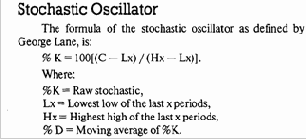OSCILLATORS (continued)
Relative Strength Index (RSI)
The formula for the RSI is:
RSI = 100— 100/[(Up Average/Down Average) + I].
Where:
Up Average = The average of closes in a given amount of time that are higher than the previous close. Down = The average of closes in a given amount of time that are lower than the previous close. The RSI is a momentum indicator based upon price movement over a specified period of time created by Welles Wilder. Some of the Droblems that are apparent in other momentum oscillators are eliminated in the RSI. Namely, by taking the up average and down average instead of the difference of prices, a smoother oscillator is created. For example, in a 14-day RSI the up average of the last 14 days is derived, as is the down average of the last 14 days. A constant band is created as well (from 0 to 100) which facilitates analysis of different securities.
The RSI is used as any momentum oscillator. Directional
movement, peaks, troughs. Divergence and crossing between short term and long term RSI's are looked for in the chart.
Overbought/oversold signals are given by crossing the 70 and 30 lines according to Welles Wilder. Instead of focusing only on the crossing of the overbought/oversold line, peaks and troughs of the oscillator should be examined for signals, with peaks expected to be at higher levels in a bull market than in a bear market, troughs occurring at lower levels in a bear market than a bull market. A peak in the RSI would suggest a price turn around to lower levels could be ahead, while a trough in the RSI suggests the opposite. Longer term RSI's will have less vitality than shorter term RSI's, if many overbought/oversold signals are desired, use of a shorter term RSI would generate them, but these will not have the same weight as the less sensitive RSI in terms of medium to long term trends.
|
Vocabulary
|
e
|
momentum - скорость движения
|
|
|
i
|
to eliminate — уничтожать, снимать
|
|
|
u:
|
smooth — гладкий, ровный
|
|
|
ai
|
to derive - получать
|
|
|
э:
|
raw — грубый
|
 Содержание Назад Вперед
Содержание Назад Вперед
|





